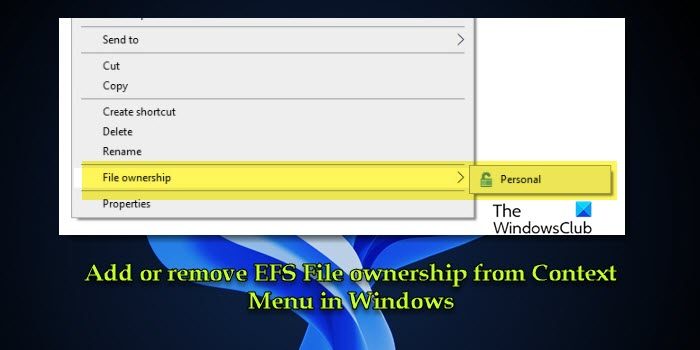Encryption is the strongest protection that Windows provides to help you keep your files and folders secure. When you encrypt a file or folder with EFS, File ownership will be available in the context menu of the file or folder to make it easier to decrypt. In this post, we will show you how to add or remove the EFS File ownership context menu of files and folders for all users in Windows 11/10.

Add or Remove EFS File ownership from Context Menu
You must be signed in as an administrator to add or remove the File ownership from the context menu in Windows 11/10.
To add or remove the File ownership from the context menu in Windows 11/10, do the following;
To add EFS File Ownership to Context Menu
- Press Windows key + R to invoke the Run dialog.
- In the Run dialog box, type notepad and hit Enter to open Notepad.
- Copy and paste the syntax below into the text editor.
[HKEY_CLASSES_ROOT\*\shell\UpdateEncryptionSettingsWork]
"AppliesTo"="System.StorageProviderId:<>\"network\" AND System.StorageProviderProtectionMode:<>1 AND System.StorageProviderProtectionMode:<>2"
"AttributeMask"=dword:00002000
"AttributeValue"=dword:00002000
"ExtendedSubCommandsKey"="*\\shell\\UpdateEncryptionSettingsWork"
"ImpliedSelectionModel"=dword:00000000
"MUIVerb"="@efscore.dll,-101"
"MultiSelectModel"="Player"
"Position"="Bottom"
[HKEY_CLASSES_ROOT\*\shell\UpdateEncryptionSettingsWork\Shell\Decrypt]
"AttributeMask"=dword:00002000
"AttributeValue"=dword:00002000
"CommandStateHandler"="{5B6D1451-B1E1-4372-90F5-88E541B4DAB9}"
"Icon"="edputil.dll,-1002"
"MUIVerb"="@efscore.dll,-103"
"ShowAsDisabledIfHidden"=""
"SuppressionPolicyEx"="{2F574F12-4EAA-46CF-BCBF-4E8055002E0C}"
"UpdateType"=dword:00000000
[HKEY_CLASSES_ROOT\*\shell\UpdateEncryptionSettingsWork\Shell\Decrypt\command]
"DelegateExecute"="{5B6D1451-B1E1-4372-90F5-88E541B4DAB9}"
[HKEY_CLASSES_ROOT\Directory\shell\UpdateEncryptionSettings]
"AppliesTo"="System.StorageProviderId:<>\"network\" AND System.StorageProviderProtectionMode:<>1 AND System.StorageProviderProtectionMode:<>2"
"AttributeMask"=dword:00002000
"AttributeValue"=dword:00002000
"ExtendedSubCommandsKey"="Directory\\shell\\UpdateEncryptionSettings"
"ImpliedSelectionModel"=dword:00000000
"MUIVerb"="@efscore.dll,-101"
"MultiSelectModel"="Player"
"Position"="Bottom"
[HKEY_CLASSES_ROOT\Directory\shell\UpdateEncryptionSettings\Shell\Decrypt]
"AttributeMask"=dword:00002000
"AttributeValue"=dword:00002000
"CommandStateHandler"="{5B6D1451-B1E1-4372-90F5-88E541B4DAB9}"
"Icon"="edputil.dll,-1002"
"MUIVerb"="@efscore.dll,-103"
"ShowAsDisabledIfHidden"=""
"SuppressionPolicyEx"="{2F574F12-4EAA-46CF-BCBF-4E8055002E0C}"
"UpdateType"=dword:00000000
[HKEY_CLASSES_ROOT\Directory\shell\UpdateEncryptionSettings\Shell\Decrypt\command]
"DelegateExecute"="{5B6D1451-B1E1-4372-90F5-88E541B4DAB9}"
- Now, click the File option from the menu and select Save As button.
- Choose a location (preferably desktop) where you want to save the file.
- Enter a name with .reg extension (eg; Add-FileOwnership-ContextMenu.reg) and choose All Files from the Save as type drop-down list.
- Double-click the saved .reg file to merge it.
- If prompted, click on Run > Yes (UAC) > Yes > OK to approve the merge.
- You can now delete the .reg file if you like.
To remove EFS File Ownership from Context Menu

- Open Notepad and copy and paste the syntax below into the text editor.
[-HKEY_CLASSES_ROOT\*\shell\UpdateEncryptionSettingsWork] [-HKEY_CLASSES_ROOT\Directory\shell\UpdateEncryptionSettings]
- Save the file to your desktop with .reg extension (eg; Remove-FileOwnership-ContextMenu.reg) and choose All Files from the Save as type drop-down list.
- Double-click the saved .reg file to merge it.
- If prompted, click on Run > Yes (UAC) > Yes > OK to approve the merge.
- You can now delete the .reg file if you like.
That’s it on how to add or remove EFS File Ownership from Context Menu in Windows 11/10!
Read: An error occurred applying attributes to the file in Windows.
How to remove file ownership lock?
You may remove the ownership lock of files encrypted by other users (using Windows Encrypting File System) via Advanced Properties. Right-click the file and choose the Properties option from the context menu. Click the Advanced button at the bottom of the General tab. Uncheck the ‘Encrypt contents to secure data’ option and click OK. Return to the Properties window and click OK. In the confirmation prompt, select ‘Apply change to this folder, subfolders, and files’, and then click OK.
How to take ownership of a file to delete it?
Open File Explore, navigate to the file, right-click on it, and select Properties. Switch to the Security tab in the Properties window and click the Advanced button. Click Change next to ‘Owner’ in the Advanced Security Settings window. Click the Advanced button at the bottom of the Select User or Group window. Click the Find Now button in the Advanced window. Navigate to your username in the list of users and click on it. Click OK. Back in the Security tab, click Edit, select your user account, grant Full control, and click Apply and OK. Now, right-click the file and select Delete.
Read Next: Fix The Active Directory Domain Services is currently unavailable.
Leave a Reply